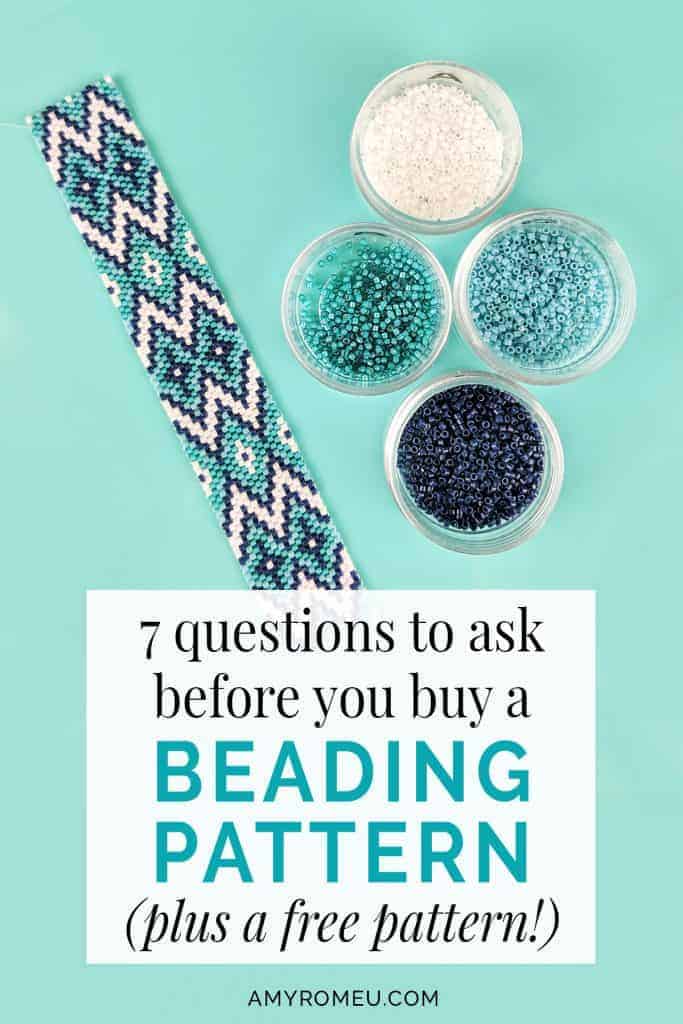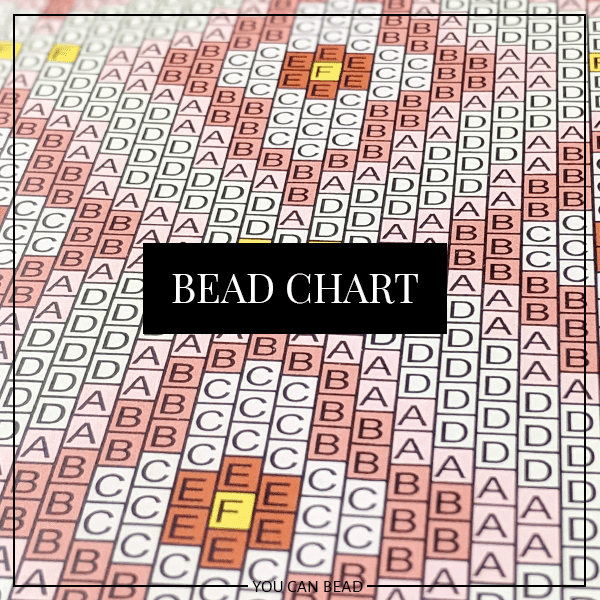how to make bead bracelet design peyote

Have you ever been disappointed by a beading pattern purchase? I know I have!
These 7 questions to ask before you buy another beading pattern will help you choose the perfect beading pattern for your next DIY jewelry making project!
Beading patterns are so fun to buy, and it's exciting to browse Etsy or Pinterest for beading patterns before starting a new project. Sometimes the pattern we choose isn't a good fit for us, and we end up frustrated! To solve that problem, consider the following 7 tips to be sure you don't waste any more money on beading patterns!
Before we begin, I want to make it clear that the beading patterns I'm referring to in this post are peyote stitch and beading loom patterns. These patterns are usually for wide, flat bracelets woven with very small Delica or other glass seed beads. Even if you don't bead using a loom or Peyote Stitch or a loom, these tips will still be helpful when starting a new beading project.
If you're already a beading pattern lover, I have a free gift for you, too! You can download the pattern shown in the photo above for free! It's my way of saying thanks for visiting my blog! You can get the free pattern file from a link at the bottom of this post.
Ok... let's get started!
1. What beading technique does the pattern use?
This tip may be obvious, but I must say I've gotten caught up in the design of a pattern without confirming this very basic piece of information. Flat bead woven bracelets like loom work and peyote stitch can look very similar at first glance. However, if you buy a loom bracelet pattern and you don't have a loom because you prefer peyote stitch, you'll be disappointed.
2. What skill level is the pattern?
Have you ever bought a beading pattern impulsively because you loved how the design looked? Maybe you weren't familiar with the beading technique, but figured you'd learn it through the beading pattern instructions. But when you dug further, you discovered that the pattern was just that - a pattern with no beading instructions? I know I have, and it is frustrating!
There is no standard bead pattern format that bead pattern sellers must follow. Some pattern designers provide full instructions for the beading technique used for the project. Others assume the beader is familiar with the technique and are just selling their beaded design art. You may find that for projects using your favorite technique, you don't need any basic instructions. However, if you haven't loomed in a long time, you might want a refresher.
Thankfully, most good beading pattern designers clearly state whether or not the pattern includes instructions for the technique. Check for this information in the beading pattern description, and if you don't see it, send the seller a message and inquire before purchasing.
3. How many bead colors are needed to complete the beading pattern?
This one is a big one! I recently came across an Etsy shop with gorgeous beaded patterns. The wide peyote stitch bracelet designs featured detailed imagery of flowers, birds, and faces.
How did the beading pattern artist accomplish the incredible detail and vivid imagery through beads?
By using A TON of beading colors, that's how.
One (negative) review left for this store with beautiful patterns said the image was beautiful, but the buyer didn't realize the pattern called for over 45 different bead colors!
More beading colors means one thing - lots of money! For beading patterns that use Delica beads for example, a pattern using 20 Delica colors you don't have on hand could cost anywhere from $80-$125 to purchase. Of course, you'll have the beads for more than one project, but the initial investment in beads will be steep.
If you are new to bead weaving, be sure to check to see how many bead colors are required for the pattern you are interested in. I like to work patterns with 10 colors or less - not only are they less expensive to buy beads for, but they are much easier make.
I say that because it's easier to set up a bead tray with the supplies for a 6 color project than a 25 color project. When bead weaving, each bead needs to be clearly labeled and readily available while beading the pattern. A lot more time and headache will go into setting up your beading tray for a pattern with more colors. Also, if you like to travel with your bead project (like I do!), patterns with less colors are much more portable.
4. What's the longevity of this pattern?
Wait a minute, you may be thinking. How is a pattern an investment? Most beading patterns are quite affordable, that's true.
However, choosing a pattern has more costs beyond the price of the pattern. There are of course the beads to purchase, and the investment of time in creating the project. You may spend several hours creating a beaded bracelet or necklace from a pattern. So how do you choose a pattern that will give you the most bang for your buck?
Beading patterns that have the most value are ones that can be reused over and over. An example is a geometric or flora pattern that can be recolored in a variety of ways. You purchase the pattern once, and can reinterpret it several different ways by using different bead colors and finishes. Boom!
An example of a beading pattern that doesn't have as much value or longevity (but it still super fun!) is a pattern featuring a celebrity's face, or The Empire State building. Those beading patterns are more of a one time use pattern.
5. Is the instructional format of the beading pattern written in YOUR preferred learning style?
Beading patterns can be written in a few different formats. The bead chart format uses two parts - a bead color chart and a color coded grid. The bead color chart shows the bead colors used in the grid and their corresponding bead names and numbers for easy ordering.

The corresponding color coded bead grid features the letters and colors of each bead. They are designed to be read from left to right, row by row. Some beaders (like me) are visual learners, and prefer this beading pattern style. They may use a ruler and a pencil to keep track of the completed rows.

Other beaders prefer the word chart format. This format has written directions that spell out in words every bead that is used in every row (3 of bead coded "E", 4 B, 1 A, etc). You'll match the bead letter back to the color key provided with the pattern.
The directions are a series of these text descriptions. The directions also tell you which direction you are beading for each row - left or right. If this is your preferred beading pattern style, avoid disappointment by checking the description carefully, and asking the seller if necessary.
Don't forget you can download the blue and white bead pattern shown in this post for free! It's my way of saying thanks for visiting my blog! You can get the free pattern file from a link at the bottom of this post.
6. Does the pattern have comprehensive clasp instructions (if you need them)?
Some patterns are beautiful, but don't have clear instructions on how to finish off your new creation. In fact, the bead pattern creator may not have a certain clasp or closure in mind, leaving you to brainstorm and research the perfect closing element. They may be creating lovely looking patterns without taking the additional steps to show you how to professionally finish off the piece. This makes for a less than desirable beading pattern if you don't already know how to finish off certain kinds of beaded jewelry items.
For example, a wide loom bracelet will need a specific clasp or closure to finish it off professionally. A really good bead pattern designer will have the size and measurements of a specific clasp in mind while designing the pattern. Even better, they will tell you exactly what size clasp or closure to buy for the best look. That way you aren't left wondering how to finish off your latest work.
7. Does the pattern sample photo use real beads, or is it computer generated?
This one is not a deal breaker for me, but it's worth mentioning.
Bead pattern creation software is very powerful. It can generate full color images of patterns based on the bead colors the artist selects during the designing process. However, computer generated bead patterns can't replicate the actual bead colors, or more importantly, the nuances different bead finishes add to the final piece.
If you are wondering how the finished product created from a pattern will look, it's always best to choose a pattern that has an actual beaded sample rather than a computer generated image. That way you can be certain of the finished result.
The Takeaway
Choosing a new bead pattern and taking on a new beading project can be so fun! If you choose your pattern quickly without answering questions like the ones I've mentioned above, you might be disappointed. However, with a little extra time and preparation, you can love your next beading pattern, and it may easily become one of your favorites!
What beading pattern format do you prefer? Bead chart, or word chart? Let me know in the comments below.
Until next time... and happy creating!

Oh, hey, want the FREE beading pattern I mentioned earlier?
Get it from our Resource Library!You'll receive the password for the Resource Library instantly after filling out the form below!
Want to remember this? Post 7 Questions To Ask Before You Buy A Beading Pattern to your favorite Pinterest board!

how to make bead bracelet design peyote
Source: https://amyromeu.com/7-questions-to-ask-before-you-buy-a-beading-pattern/
0 Response to "how to make bead bracelet design peyote"
Post a Comment